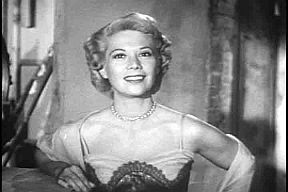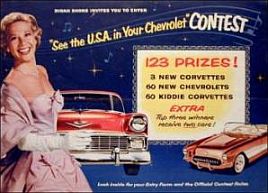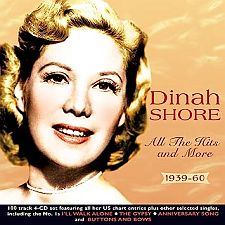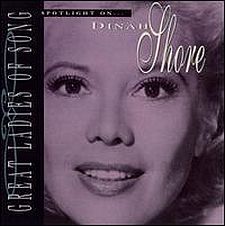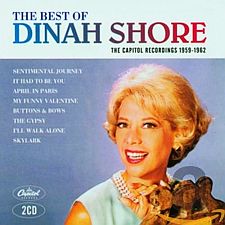
Dinah Shore in prime time – on the TV studio set of her ‘Chevy Show,’ probably sometime in the 1950s.
Dinah Shore was one of the first television celebrities whose name became synonymous with a product — and not just any product. For Dinah Shore was perhaps the one person in the 1950s and early 1960s most responsible for putting Chevrolet automobiles in the driveways and garages of millions of Americans. In doing so she became the “queen of General Motors” in its heyday — a super-salesperson and more. For in this role, Dinah Shore also became a 1950s’ cultural icon — and for millions, a much-admired and trusted personality.
But before she became “Ms. Chevrolet”, Dinah Shore was a well-known singer and entertainer who worked hard at her craft; a person who had traveled from blues on the radio and entertaining the troops during WWII, to leading a nation to suburbia and the open highway. In later years she also helped define the female talk show format with a genteel, kitchen-table style, presaging in some ways Oprah Winfrey’s show and “The View,” though without the sharp elbows in the latter case.
The Chevy Jingle
|
“See the USA in your Chevrolet, |
In her prime-time days as a 1950s TV show hostess and performer, Dinah Shore rose to the top of her craft and became a national celebrity. With a likeable mixture of Southern charm, good looks, and friendly hospitality, she became one of America’s favorite TV personas of the era, making millions of viewers feel good about themselves and their country. On her TV show for many years she sang “the Chevy jingle” at the show’s opening and closing. The short song — which included the lines “See the USA in your Chevrolet… America’s the greatest land of all” — became something of an anthem for the era; a tune approaching patriotic status. Her sweeping good-bye kiss thrown to the audience at the end of each show became her trademark gesture, and a genuine part of her hospitable style.
Tennessee Roots
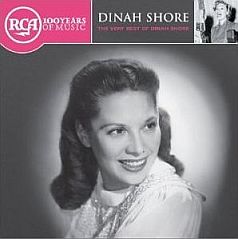
Young Dinah Shore as a brunette, before she became the blonde TV host, shown here on a 2001 CD from RCA. Click for CD.
“When I was four or five,” she would later recall, “my father had a general store in Winchester and I don’t think the farmers could ever leave on Saturday afternoon until I had been placed up on the counter to sing.”
Also encouraged by her mother who once had operatic ambitions, Dinah learned to play the ukelele, took voice lessons, and ventured out in amateur dramatics with a night-club appearance at age fourteen. She went on the Vanderbilt University where she studied sociology. While in college, she made her radio debut with a regular 15-minute program on the Nashville station WSM. The radio theme song there, “Dinah,” a 1925 hit tune, later inspired her name change. She used her radio earnings to help pay her college costs.
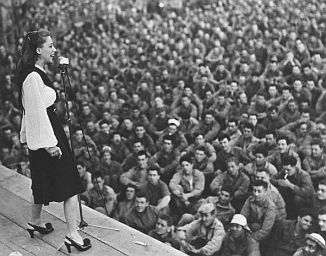
Dinah Shore, a popular singer of her day, traveled with USO tours in Europe to entertain the troops; 1943 or so.
On domestic radio, she also had her own half-hour show in 1943, “Call for Music,” sponsored by General Foods. In Hollywood, she had appeared in a few films, such as Belle of the Yukon, Up in Arms, and others, but acting was not her strong suit. She also did several songs for Walt Disney productions, with her voice used in Disney animations. Her recordings, meanwhile, continued to do well. Through the 1940s she sold one million copies of “Yes, My Darling Daughter.” Between 1940 and 1955, she would have some 75 hit records. Among these were: “The Gypsy” (1946), “The Anniversary Song” (1947), “Buttons and Bows” (1948) and “Dear Hearts and Gentle People” (1949). Her record sales were well over 6 million by the late 1940s. That’s about when she began to venture into the new medium of television starting on the Ed Wynn Show.
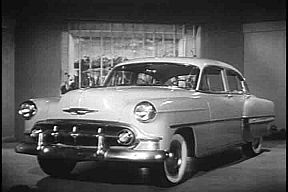 The Chevrolet Bel Air model for 1953. |
TV & Chevrolet
In 1950 she made a guest appearance on Bob Hope’s first NBC television special. The following year, NBC gave her a quarter-hour show in the early evening which ran twice weekly. It was called the Dinah Shore Show. It was the first network show hosted by a woman.
GM’s Chevrolet division became her sponsor. For some months prior to the show, talks had gone on with the sponsor. According to Bruce Cassiday in his book, Dinah!:
“The Chevrolet Division of General Motors made no secret of it: they wanted to sell cars not only to men but to women as well. Dinah Shore had already proved herself as a ‘seller’ with the servicemen in World War II. Her image was that of the girl next door… The women [in her audience], it was hoped, would approve of having her in their homes.”
Chevy and GM joined Dinah Shore from the beginning of her TV career. It also didn’t hurt that RCA/NBC corporate chief, David Sarnoff, liked Shore’s choice of music and her mainstream appeal. The Dinah Shore Show, in its shorter, twice weekly format, would run through July 1957. However, she would soon have a full hour on Sunday nights, reaching millions. Some of her longer shows began as specials in 1956. More on the longer show in a moment.
General Motors by then, as other major companies, had begun to use television-show sponsorship and television advertising to push their product. Chevrolet, in fact, even in the early 1950s, had the single largest advertising budget in the business, handled by the advertising agency Campbell-Ewald. Some years later, Campbell-Ewald would take credit for “launching” Dinah on her November 1951 show where she began singing the Chevrolet song.
By the fall of 1952, Dinah Shore, in addition to singing the Chevy jingle on her new show, was also making TV commercials for Chevrolet. She had made one “See the USA” TV commercial in 1952 featuring the Chevrolet song and Chevrolet cars traveling the roads of America.
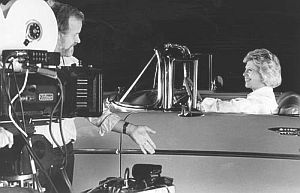
Dinah Shore making TV ad for what appears to be a mid-1950s Chevrolet model.
Another film short made for Chevrolet in the fall of 1952 features its new 1953 Chevrolet Bel Air model (earlier photo above right). The 12-minute film, titled “A New Star,” opens on the set of television studio as Shore is filmed singing an entire song about spring. After the song, she addresses her audience to talk about the beauty and various features of the new Chevy model, then heads to the dressing room for a wardrobe change for another song. A salesmen then comes on the set with “actor consumers” as the staged filming of the ad continues. The salesmen makes his best Chevrolet pitch as the camera pans the new car. Dinah, meanwhile, returns in a new outfit and sings the whole version of “See the U.S.A. in your Chevrolet.” Throughout her career with Chevrolet as her sponsor, Dinah Shore would continue to make TV and print ads, auto show appearances, new dealer dedications, race track appearances, and other Chevrolet product endorsements and special appearances.
Dinah’s Chevy Show

Dinah Shore singing on her show with Mahalia Jackson.
Dinah’s show ran on weekend evenings, mostly Sundays, and included popular guests of the time such as Peggy Lee, Frank Sinatra, Pearl Bailey, George Burns, Jack Lemmon, Mahalia Jackson, Groucho Marx, Bing Crosby, Red Skelton, Shirley Temple, Nat King Cole, and others. Dinah would sometimes sing or dance with guests, or engage in comedy skits. She was the perfect hostess; a cheerful personality who fit the times and set people at ease.
Dinah Shore became quite popular by the late 1950s, winning Emmy awards for her show and was named several times to lists of “most admired” woman. But her show’s most enduring image was her signature “See-The-USA” song, as she beckoned an eager nation to the open road.
Chevrolet, meanwhile, by December 1957, was paying weekly installments of $145,000 (in 1950s’ money) for each Dinah Shore Chevy Show. Dinah’s show by then, although not the nation’s top show, still had a very respectable audience of about 44 million.A GM spokesman told Time magazine in December 1957 that the company considered its link with Dinah to be “one of the most enduring love affairs in TV.” Indeed, Dinah Shore was helping to make Chevrolet the most popular automobile brand in America. In the 1950s, Chevy sales in the U.S. averaged one million or more cars and trucks every year.
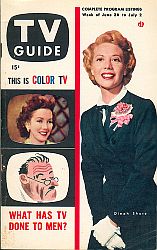 TV Guide, June 26th, 1953. |
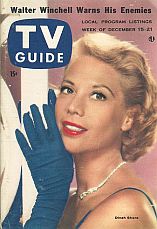 TV Guide, Dec 15th, 1956. |
 TV Guide, Dec 7th, 1957. |
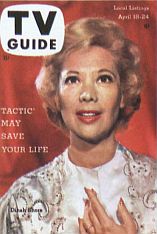 TV Guide, April 18th, 1959. |
GM’s Money & Models
It wasn’t just Dinah Shore powering Chevrolet sales forward. Chevrolet itself was spreading TV advertising dollars around liberally, as the company had been doing since the late 1940s and the days of radio. By 1960, Chevrolet alone was spending something on the order of $100 million annually (in 1960s’ dollars) on TV ads and sponsorship. Chevy was associated with a number of TV shows at various times during the 1950s, including: Dave Garroway’s “Wide Wide World”, Robert Trout’s “CBS News”, Lowell Thomas’ “High Adventure”, and various shows by Pat Boone, Garry Moore, and Milton Berle. But the performer who would personify Chevy in that era was Dinah Shore. By the early 1960s, her show was regarded as “a Sunday night staple.” Advertising Age would later write that Dinah Shore “helped make Chevy the unchallenged leader in America and the Chevy jingle one of the most famous in TV history.” But General Motors was doing its part, too, turning out the hardware. By the mid-1950s, as GM became one of the most powerful companies in the world, attractive new Chevy models were hitting showrooms all across America.
In October 1954, Chevrolet’s new line-up boasted a spiffy new model — the ’55 Chevy — with a 265 cubic inch V-8 engine that put out 160 horsepower. It was the first mass-market car with a V-8 engine. In earlier years, GM had put V-8s into its up-scale Cadillac line, but the high-revving, “small block” V-8s, as they came to be known, were the first to be put into everyday, “working-class” Chevys. These models sold like crazy. And the good times continued though the next few years with other Chevy models.
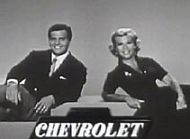
Dinah Shore & Pat Boone in TV ad for the 1958 Chevy Impala.
When the Dinah Shore Chevy Show began in 1956 it started as a series of monthly specials broadcast for an hour on Friday nights. From 1957-1961 it became the Sunday night staple, broadcast at 9 pm. In the fall of 1961, CBS came up with a new show — a western named Bonanza, destined to become one of the all-time TV powerhouse shows. Bonanza then took the 9 pm time slot. Dinah’s show then became the Dinah Shore Show, broadcast on Friday nights at 9:30pm. In its last two seasons, The Dinah Shore Show went back to Sundays at 10 pm, broadcast on a rotating basis with assorted specials. The last telecast was May 12, 1963.
By 1962-63 — roughly coinciding with the final run of her show — Chevy sales alone were more than 2 million a year. All GM models in those years accounted for fully half of all vehicles sold in the U.S. Dinah Shore had certainly done her part for Chevrolet and beyond. Even after her show went off the air, she continued to sing the Chevy song for the company in advertising for several more years. Her name would remain associated with the Chevrolet brand for many years after her formal arrangement with the company had ended.
“The Chevrolet brass were ecstatic,” wrote Bruce Cassiday in his biography of Dinah. “For ten years, right up into the fall of 1961, when she began a reduced schedule, Chevy sponsored her and listened to the jangle of cash registers as American’s bought Chevrolet’s by the millions to the tune of Dinah’s voice singing ‘See the USA in Your Chevrolet…’.”
By 1964, America had changed. The cars were different and so was the music. Ronny and the Daytonna’s 1965 hit song “Little GTO” came out shortly after a GM whiz-kid engineer/executive named John DeLorean put the actual GTO Pontiac, with its giant engine, on the street. Wilson Pickett’s song “Mustang Sally “of 1966 told a story about Ford’s hot new Mustang model. The muscle car era was in full swing. Detroit’s automakers by this time were heading in a whole new direction — and not always for the better.
|
Smog, Safety & MPG As Dinah Shore was helping America enjoy its love affair with the automobile, there were some serious automotive downsides that started to become apparent nationwide at about that time. Dinah, of course, had nothing to do with these. But by the mid-1950s, a new dangerous kind of air pollution called smog had begun to form in Los Angeles, later connected nationwide to uncontrolled automobile tail-pipe exhausts and engine emissions. Safety and auto accidents also became national concerns. Congress, in fact, had first attacked what was called the “horsepower race” in 1957, believing the rising horse-power in automobiles to be partly responsible for killing and maiming tens of thousands in speed-related accidents. Automakers then pledged not to pitch their wares for speed and to stop using racing results in auto advertising. But all of this was soon forgotten and pushed aside by 1962, as the muscle-car era dawned. Pollution control in automobiles, meanwhile, remained minimal, even as a U.S. Justice Department lawsuit was initiated in 1969 against Detroit’s auto- makers alleging a 1954-to-1969 conspiracy to hold back pollution-control technology. This suit was settled out of court, but the automakers continued to drag their feet on pollution control and automotive fuel economy for decades. On the safety front, a consumer advocate named Ralph Nader, emerged in 1965 with book Unsafe at Any Speed, attacking the poor safety record of Detroit’s automakers, sparking a consumer movement and new auto safety laws. By the mid-1970s, fuel economy became the major concern, with Detroit again faring poorly in the miles-per-gallon (MPG) competition as Japanese automakers engineered more efficient models. |
Dinah Can’t Help
Years later, in May 1999, Chevy tried to make an advertising comeback with Dinah Shore, even though she had passed on by then.
In a campaign aimed at resurrecting GM’s Chevrolet Impala model, the company brought back Dinah’s “See the U-S-A-in-Your-Chevrolet” anthem and mounted a brief ad campaign with her appearing in some retro ads.
Using a bit of televised techno-wizardry, they had Dinah on-screen, appearing to chat with then Chevy General Manager, Kurt Ritter about Chevy’s greatness.
Off screen, Ritter explained that the old Chevy jingle scored well with Baby Boomers who fondly remembered the Eisenhower years. Chevy also found that even GenX-ers who never knew Dinah Shore, were intrigued with the cheery message she offered, encouraging them to get in their car and hit the road.
Back in the heyday of Impala, Chevy had sold over a million of the full-size models annually. But by 1999, Chevy had stiff competition from the Ford Taurus, the Honda Accord, and the Toyota Camry. They were hoping to sell 400,000 or so Impalas with the the new campaign, but even that was optimistic. As it turned out, not even a resurrected Dinah Shore could help at that point.
GM’s Tech Failures
Instead, for decades, Detroit’s Big Three became their own worst enemy, spending time and money opposing progressive public policy and technological change rather than leading it.
Opposition to improved automotive fuel economy from the 1980s through the early 2000s made matters worse. Other poor decision-making, bad investments, ill-advised mergers and acquisitions, and an over-the-top emphasis on SUV and light truck production all contributed to Detroit’s continuing problems, leading in part to their economic woes of the mid-and late 2000s.
|
“See The USA…” See the USA in your Chevrolet On a highway, or a road along the levy So make a date today to see the USA Traveling East, Traveling West See the USA in your Chevrolet Whether traveling light or with a load that’s heavy So make a date today to see the USA |
Dinah the Icon
Dinah Shore, meanwhile — after her variety show went off the air in 1963 — would fade from the public eye briefly. But she would later continue her television career with a series of talk shows.
During the 1960s, she raised a family, occasionally made a few TV specials, continued singing, and was still listed in Gallup polls citing her among America’s most admired women.
In 1970, she initiated her first talk show, Dinah’s Place (NBC, 1970-74), followed by Dinah! (1974-79) and Dinah and Friends (1979-84) — the latter two, 90-minute daily shows syndicated on CBS stations. A Conver-sation with Dinah (1989-91) was her final daytime show, which ran on the Nashville Network cable channel.
During her 20-year talk-show run, however, she became one of the most popular personalities on daytime TV and a pioneer for others who would follow her in that format.
Divorced from former husbands George Montgomery, an actor, and Maurice F. Smith, a tennis player, Dinah Shore’s love life received some national tabloid attention in the 1970s when she became involved with a much younger Burt Reynolds for six years.
Shore was also an avid golfer and a long- time supporter of women’s professional golf. In 1972, she helped found the Colgate Dinah Shore golf tournament, which today is known as the Kraft Nabisco Championship. The tournament is held each spring near Shore’s former home in Rancho Mirage, California. The event remains one of the four major golf tournaments on the Ladies Professional Golfers Association Tour. Shore also wrote series of cookbooks, including in 1971,the best-selling Someone’s in the Kitchen With Dinah.
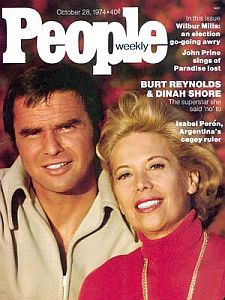
Dinah Shore & Burt Reynolds, ‘People’ magazine, October 28, 1974.
In 1993, she was diagnosed with cancer. She passed away less then a year later in February 1994 at her home in Beverly Hills. She was 77.
In her childhood hometown of Winchester, Tennessee, there is a “Dinah Shore Blvd” that leads to the town square where her father once had his store.
In California, as well, there is a road named after her — “Dinah Shore Drive” — a busy road that runs through the desert cities of Rancho Mirage and Cathedral City.
Dinah’s former husband, actor and sculptor George Montgomery, produced a life-size statue of her that stands near the 18th hole at the Mission Hills Country Club golf course in Rancho Mirage, CA.
The statue, along with “Dinah’s Walk of Champions,” were dedicated formally by Nabisco in March 2000 with remarks by former president Gerald Ford.
In August 2009, she was one of twenty 1950s’ TV icons to appear on a commemorative U.S. postage stamp.
50 Years Broadcasting
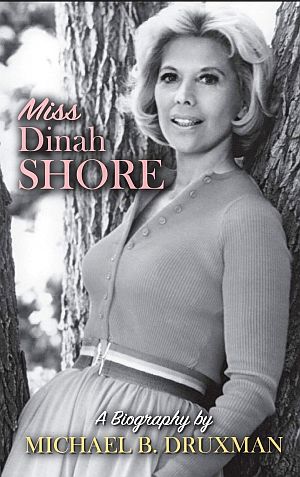
Michael B. Druxman’s 2015 book, “Miss Dinah Shore: A Biography,” BearManor Media, 212 pp. Click for Amazon.com
Dinah Shore had a prominent presence in broadcasting — and in the public eye — a presence that spanned more than 50 years. Hers was a career that began in late-1930s radio and continued with television until 1991. And whether in radio, popular recording, or television, she made her mark.
Dinah Shore had 75 hit records between 1940 and 1955. In television, her ten Emmy awards makes her one of the most honored females in the award’s history. In 1992, she was inducted into the Academy of Television Arts and Sciences’ TV Hall of Fame. She also won a Peabody Award and a Golden Globe.
Still, in all of her career accomplishments, Dinah Shore is perhaps best remembered for burnishing the Chevrolet brand into the national psyche.
The 1951-through-1963 era framed a “feel good” time for most Americans, happy about their cars and the open roads they drove on. It might well be called “the Dinah Shore era.” It was certainly a golden era for Chevrolet and General Motors. And Dinah Shore helped make it golden — at least for a time.
For additional stories on notable women at this website see, “Noteworthy Ladies,” a topics page with more than 30 story choices. Other GM-related stories include: “The DeLorean Saga: 1960s-1980s” (about GM wunderkind, John DeLorean, and his departure to build the DeLorean Motor Car); and “GM & Ralph Nader: 1965-1971″ (about the controversy surrounding GM and Ralph Nader following Nader’s damning book on the Chevrolet Corvair, Unsafe at Any Speed).
Thanks for visiting – and if you like what you find here, please make a donation to help support the research, writing, and continued publication of this website. Thank you. – Jack Doyle
__________________________________
|
Please Support Thank You |
Date Posted: 22 March 2009
Last Update: 12 June 2023
Comments to: jackdoyle47@gmail.com
Twitter: https://twitter.com/PopHistoryDig
Article Citation:
Jack Doyle, “Dinah Shore & Chevrolet, 1956-1963,”
PopHistoryDig.com, March 22, 2009.
_____________________________
Sources, Links & Additional Information
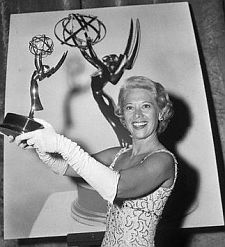 Dinah Shore picking up Emmy award for 'best female singer', March 1956. |
“Dinah Shore With Troops Abroad,” New York Times, Wednesday, August 2, 1944, Business, p. 32.
“Dinah Shore Stirs 7,000 at Stadium; Radio and Film Star Shares Honors With Goodman in Philharmonic Program,” New York Times, Wednesday, July 4, 1945, Amusements, p. 10.
“Dinah Shore in London; Singer Wins Ovation in Show at Palladium Theatre,” New York Times, Tuesday, August 31, 1948, Amusements, p. 15.
George Gallup, “Dinah Shore Favorite in Vocalist Poll,” Los Angeles Times, January 1, 1951, p. 17.
The Dinah Shore Show (sample, 15-minute show). Dinah sings “Getting to Know You,” “Stardust,” and others, November 29, 1951. In the NBC Collection of the Motion Picture, Broadcasting and Recorded Sound Division, Library of Congress, Washington, D.C.
Jack Gould, Radio & Television, “Dinah Shore Scores in Her New N.B.C. Video Series…,” New York Times, Monday, December 3, 1951, Business, p. 37.
“Dinah Shore’s TV Art.” Look, December 15, 1953.
Val Adams, “N. B.C. Still Seeks Spot for 2 Stars; Cuts in Sunday Drama Shows Urged to Open TV Time for Dinah Shore and Bob Hope…,”New York Times, Tuesday, July 24, 1956, p. 53.
“Television: Is There Anyone Finah?,” Time, Monday, December16, 1957.
“Dinah Shore Brings ‘Chevy Show’ East,” New York Times, Monday, January 13, 1958, p. 49.
Val Adams, “Dinah Shore, Hope Named for Prizes; To Receive Peabody Awards Here Today…”, New York Times, Wednesday, April 2, 1958, p. 63.
“‘Chevy Show’ Is Set for Tv All Summer,” New York Times, Wednesday, April 2, 1958, p. 63.
The Dinah Shore Chevy Show ( sample, 60-minute show). Cast: Gwen Verdon, Art Carney, Louis Jourdan, October 5, 1958. In the NBC Collection of the Motion Picture, Broadcasting and Recorded Sound Division, Library of Congress, Washington, D.C.
“Dinah Shore and Her TV Glad Rags,” Life (cover story), February 1, 1960.
“Dinah Shore Is Award Winner,” Washington Post-Times Herald, August 27, 1960, p. D-7.
George Eells, “Dinah Shore: How She grew, How She lives, How She Dresses, How She Drives Herself,” Look (cover story), December 6, 1960. In-depth article with photos. Dinah Shore cover photo by Bob Vose.
Dinah Shore Renews Pact for ’60’-61 Season,” Los Angeles Times, April 15, 1960, p. A-9.
“Dinah Shore, Chevrolet To Part After 10 Years,” Washington Post-Times Herald, February 17, 1961, p. C-8.
Dorothy Kilgallen, “Dinah Shore to Plug Peace Corps,” Washington Post-Times Herald, December 8, 1964, p. B-12.
Bruce Cassiday, Dinah! A Biography, New York: Franklin Watts, 1979.
Jack Lloyd, Knight-Ridder Newspapers, “Bubbly Dinah Shore Does a Really Live Show,” Chicago Tribune, August 28, 1986, p. 10.
Ken Gross, “Impala: It’s Not A Great Car,” Automotive Industries, May 1999.
Stephen Holden, “Dinah Shore, Homey Singer And Star of TV, Dies at 76,” New York Times, February 25, 1994.
Jim Brennan, “Favorite Automobile Spokesperson: See the USA in Your Chevrolet with Dinah Shore,” Car Domain .com, February 24, 2009.
“Biography for Dinah Shore,” TCM.com, accessed March 2009.
PBS, “MWAH!: The Best of The Dinah Shore Show 1956-1963,” March 2003. This hour-long, PBS TV special includes videotape footage of Dinah doing duets with guests Ella Fitzgerald, Jack Lemmon, Frank Sinatra, Bing Crosby, Pearl Bailey, George Burns, Groucho Marx, Peggy Lee, and Mahalia Jackson.
Video. “A Great New Star,” is a 1952 video produced by the Handy (Jam) Organization for the Chevrolet Motor Division of General Motors Corp., featuring Dinah Shore as hostess, who sings two songs, including the Chevy jingle, in an extended promotion piece for the new 1953 Chevrolet Bel Air model. This piece is set around the making of an advertisement, providing the viewer a behind the scenes look at studio process and actors, along with Dinah’s singing. You Tube offers the clip in two parts, each running about 6 minutes.
Dinah Shore, Someone’s in the Kitchen with Dinah, Garden City, New York: Doubleday, August 1971.
Dinah Shore, The Dinah Shore American Kitchen, 1990.
Douglas Gomery, “Dinah Shore: U.S. Musical Performer,” The Museum of Broadcast Communications, accessed March 2009.
Henry B. Aldridge “The Dinah Shore Show,” The Museum of Broadcast Communications, accessed March 2009.
